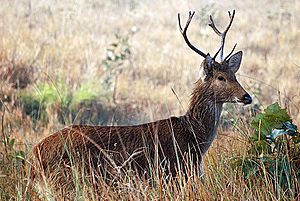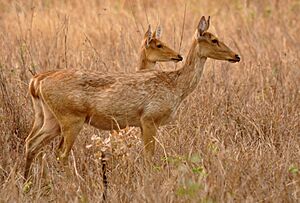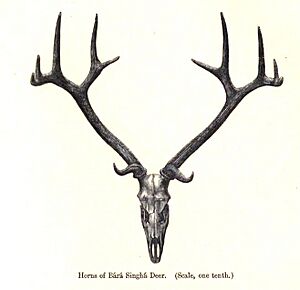Barasingha facts for kids
Quick facts for kids Barasingha |
|
|---|---|
 |
|
| Male | |
 |
|
| Adult female and yearling | |
| Conservation status | |
| Scientific classification | |
 |
|
| Historic range (yellow); relict populations: duvaucelii (red); branderi (green); ranjitsinhi (blue) |
The barasingha (Rucervus duvaucelii), also known as the swamp deer, is a type of deer. It lives in the Indian subcontinent. You can find groups of them in northern and central India. There are also two separate groups in southwestern Nepal. Sadly, they no longer live in Pakistan and Bangladesh. We are not sure if any are left in Bhutan.
The name duvaucelii honors a French naturalist named Alfred Duvaucel.
The swamp deer is special because its antlers have more than three points, called tines. This is different from other Indian deer. Because of this, it is called bārah-singgā in Hindi. This means "twelve-horned". Adult male deer usually have 10 to 14 tines. Some have even been seen with up to 20!
In Assamese, the barasingha is called dolhorina. The word dol means swamp.
Contents
What Does a Barasingha Look Like?
The barasingha is a large deer. It stands about 44 to 46 inches (112 to 117 cm) tall at the shoulder. Its body, from head to tail, is almost 6 feet (183 cm) long. Its fur is a bit woolly and yellowish-brown on top. It is lighter underneath, with white spots along its back.
The throat, belly, inner thighs, and under the tail are white. In summer, their coat turns a bright reddish-brown. Males have a mane on their neck. Females are usually lighter in color than males. Young barasingha are born with spots.
The average antlers are about 30 inches (76 cm) long when measured along the curve. They are about 5 inches (13 cm) around in the middle. The longest antler ever recorded was 41 inches (104.1 cm) long.
Male barasingha weigh between 170 to 280 kg (370 to 620 lb). Females are lighter, weighing about 130 to 145 kg (290 to 320 lb). Very large males have weighed up to 460 to 570 lb (210 to 260 kg).
Where Do Barasingha Live?
Swamp deer used to be common in many places. This included parts of the Upper Narmada Valley and Bastar. They like flat or wavy grasslands, floodplains, and marshes. They usually stay near the edges of forests. Sometimes, you can also find them in open forests.
In the 1960s, there were about 1,600 to 2,150 barasingha in India. About 1,600 were in Nepal. Today, their homes are smaller and more spread out. This is because of too much hunting and turning their land into farms between the 1930s and 1960s.
In Nepal, you can mostly find them in the western parts. They live south of the Himalayas in Shuklaphanta and Bardiya National Parks. In India, barasingha live in six places in Uttar Pradesh. They are also in Kanha National Park in Madhya Pradesh. Some have been seen in Chhattisgarh, which is the furthest south they live.
They are no longer found in West Bengal. They are probably also gone from Arunachal Pradesh, Bihar, Jharkhand, Meghalaya, Nagaland, and Odisha. A few barasingha still live in Assam's Kaziranga and Manas National Parks.
In 2005, a small group of about 320 barasingha was found. This was in the Jhilmil Jheel Conservation Reserve in Haridwar district, Uttarakhand. This is likely the furthest north the species lives.
Types of Barasingha (Subspecies)
There are three main types, or subspecies, of barasingha:
- Western swamp deer (R. d. duvauceli): This type loves water. It has wide hooves that help it walk in flooded grasslands. These are found in the Indo-Gangetic plain. In the early 1990s, there were about 1,500–2,000 in India. In Nepal's Shuklaphanta Wildlife Reserve, there were about 1,500–1,900. This group grew to 2,170 in 2013. Some zoos, like the San Diego Zoo in California, have successfully bred these deer since the 1970s. They live in a large, natural area called the "Asian Plains."
- Southern swamp deer (R. d. branderi): This type has hard hooves. It lives on hard ground in open sal forests with grass. They only live in Kanha National Park. This park is between Chhattisgarh and Madhya Pradesh. In 1988, there were about 500 of them. By 2016, there were about 750. Some have been moved to Satpura Tiger Reserve. There is also a group of southern barasingha in the United Kingdom at the Port Lympne Wild Animal Park.
- Eastern swamp deer (R. d. ranjitsinhi): This type is only found in Assam. In 1978, there were about 700. In 2021, a count found 868 in Kaziranga National Park. Another 121 were found in Manas National Park.
How Barasingha Live (Ecology and Behaviour)
Swamp deer mostly eat grass. They also eat water plants. Some of their favorite plants are Saccharum, Imperata cylindrica, and Phragmites karka. They eat all day, but mostly in the mornings and late afternoons. In winter and during the rainy season, they drink water twice a day. In summer, they drink three or more times. When it's hot, they rest in the shade of trees during the day.
In central India, barasingha herds usually have 8 to 20 deer. Some large herds can have up to 60. There are usually twice as many females as males. During the breeding season, called the rut, they form big groups of adults.
The breeding season is from September to April. Babies are born after about 240 to 250 days. This happens from August to November. The most babies are born in September and October in Kanha National Park. They usually have one baby at a time.
When they feel danger, they make loud, barking alarm calls. Compared to other deer, barasingha are more relaxed about watching for danger. They have fewer deer on guard and spend more time eating.
Dangers to Barasingha
Barasingha living outside protected areas are in danger. They are hunted illegally for their antlers and meat. These are sold in local markets. Swamp deer have lost most of their natural homes. This is because wetlands were turned into farms. Their homes are now small and separated.
The places they still live in, like national parks, are also in danger. Rivers are changing, and there is less water in summer. More dirt is building up in the water. Local people also cut grass, wood, and illegally farm on government land. This harms the deer's habitat.
Protecting Barasingha
The barasingha (Rucervus duvaucelii) is listed as an endangered species. This means it is protected by international laws like CITES Appendix I. In India, it is protected under the Wildlife Protection Act of 1972.
There was an attempt to move some barasingha to Chitwan National Park in Nepal, but it did not work out.
Barasingha in Zoos
In 1992, there were about 50 barasingha in five Indian zoos. About 300 more were in zoos in North America and Europe.
Some swamp deer were also brought to Texas. They live in small numbers on ranches there.
Barasingha in Culture
- The barasingha is the official state animal of the Indian states of Madhya Pradesh and Uttar Pradesh.
- A "barasingh" is mentioned in The Miracle of Purun Bhagat. This is a story in The Second Jungle Book by Kipling. Since the story is set in the Himalayas, it likely refers to the western swamp deer.
See also





